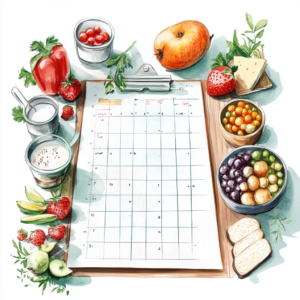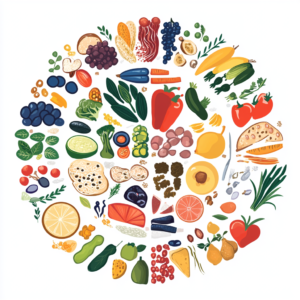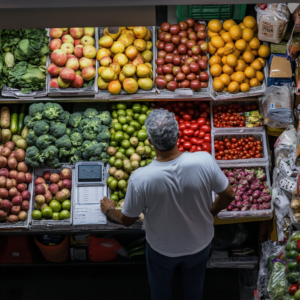Introduction
Welcome, fellow health enthusiasts! I’m excited to share this comprehensive guide on How to Plan a Balanced Vegan Diet for Optimal Wellness. Over the years, I have learned that a well-planned vegan diet not only supports a healthy lifestyle but also plays a crucial role in promoting overall wellness. Transitioning to a plant-based diet was a transformative experience for me—one that redefined my approach to nutrition, cooking, and even grocery shopping. In this guide, I will walk you through the essential components of a balanced vegan diet, share effective meal planning strategies, provide a sample meal plan, and offer practical tips to overcome common challenges. Whether you’re new to veganism or seeking to refine your dietary habits, this article is designed to empower you with the knowledge and tools to achieve optimal wellness through a balanced vegan diet. For additional insights into plant-based nutrition, I invite you to read 10 Essential Vegan Nutrition Tips for a Healthier Life.
Understanding How to Plan a Balanced Vegan Diet for Optimal Wellness
A balanced vegan diet is about more than just eliminating animal products—it’s about ensuring that every meal provides the necessary nutrients to support your body’s functions and promote overall well-being. Through careful planning, you can combine a variety of foods to achieve an ideal mix of macronutrients and micronutrients, ensuring that your diet is both nutritionally complete and delicious. In my personal journey, learning to plan my meals effectively has been a game changer, allowing me to enjoy vibrant flavors, maintain steady energy levels, and support my long-term health goals.

1. Understanding a Balanced Vegan Diet
To build a balanced vegan diet, it’s essential to understand the foundation of nutrition and how plant-based foods can meet all your dietary needs. This section breaks down the importance of nutritional balance and the key nutrients that you must consider.
a. The Importance of Nutritional Balance in Vegan Living
A balanced diet is one that provides your body with the right amounts of proteins, carbohydrates, fats, vitamins, and minerals. For vegans, achieving this balance can sometimes be challenging if proper attention is not given to food choices and portion sizes. I learned early on that by diversifying my food intake and focusing on whole, minimally processed foods, I could easily meet my nutritional needs. A balanced vegan diet supports everything from muscle repair and cognitive function to immune health and metabolic efficiency.
b. Key Nutrients for Optimal Wellness
Certain nutrients are especially critical in a vegan diet. Proteins, though abundant in legumes and nuts, must be consumed in a variety of sources to cover all essential amino acids. Vitamins such as B12 and D, as well as minerals like iron, calcium, and zinc, require careful consideration. Additionally, incorporating healthy fats from sources like avocados and flaxseeds helps in nutrient absorption and overall health. By understanding and prioritizing these nutrients, you can ensure that your vegan diet is not only balanced but also promotes long-term wellness.
2. Components of a Balanced Vegan Diet
A balanced vegan diet consists of a thoughtful combination of macronutrients and micronutrients derived from whole foods. Here, I will delve into each component to explain its role and significance.
a. Macronutrients: Proteins, Carbohydrates, and Fats
Proteins are the building blocks of life, vital for muscle repair, enzyme function, and immune health. In a vegan diet, proteins can be sourced from legumes, tofu, tempeh, quinoa, and nuts. Carbohydrates provide energy, especially when consumed as whole grains and starchy vegetables, which are rich in fiber and complex carbohydrates. Healthy fats, found in avocados, olive oil, and seeds, are essential for absorbing fat-soluble vitamins and supporting brain health. Together, these macronutrients create a robust foundation for your daily energy and bodily functions.
b. Micronutrients: Vitamins, Minerals, and Other Essentials
Micronutrients, though needed in smaller quantities, are equally important. Vitamins like A, C, and K, and minerals such as calcium, iron, and magnesium play pivotal roles in maintaining immune function, bone health, and overall metabolic processes. For vegans, particular attention should be paid to vitamin B12 and vitamin D, which may require supplementation or consumption through fortified foods. Incorporating a wide variety of fruits, vegetables, nuts, and seeds can help cover these essential micronutrients and prevent deficiencies.
c. The Role of Whole Foods and Superfoods
Whole foods are the cornerstone of a balanced vegan diet. They are minimally processed, retain their natural nutrients, and provide a complex mix of fibers, vitamins, and minerals. Superfoods like kale, blueberries, chia seeds, and spirulina offer concentrated nutritional benefits and can boost your overall nutrient intake. By focusing on whole foods, you ensure that every meal is packed with natural goodness, contributing significantly to optimal wellness.

3. Effective Meal Planning Strategies
Planning your meals is crucial for maintaining a balanced vegan diet. It ensures that you consistently receive the necessary nutrients and helps streamline your grocery shopping and meal prep routines. Here, I share strategies that have helped me create a successful meal plan.
a. Creating a Weekly Vegan Meal Plan
The first step in effective meal planning is to design a weekly menu. I begin by listing out the meals I want to prepare for each day—covering breakfast, lunch, dinner, and snacks. I then identify the key ingredients needed for these meals and create a detailed shopping list. This process not only saves time but also minimizes food waste and ensures that I have everything on hand to prepare nutritious meals. I recommend dedicating some time each week to plan your meals, as this proactive approach can significantly improve your dietary consistency and overall wellness.
b. Portion Control and Nutrient Distribution
A well-planned meal not only includes a variety of foods but also ensures that portions are balanced. Portion control is essential for managing calorie intake and ensuring that you receive an even distribution of nutrients throughout the day. I use a food scale and measuring cups to keep track of portion sizes, especially when preparing complex dishes. This level of detail helps me avoid overeating and maintain steady energy levels, which is key to sustaining a balanced vegan diet.
c. Time-Saving Meal Prep Techniques
Meal prepping is an invaluable strategy for busy individuals. I often set aside a few hours on the weekend to prepare large batches of ingredients—such as cooked grains, roasted vegetables, and legume-based dishes—that can be used throughout the week. By pre-chopping vegetables, cooking beans in advance, and even portioning out snacks, I ensure that healthy meals are always ready to be assembled. This practice not only saves time during hectic weekdays but also reduces the temptation to opt for less healthy convenience foods.

4. Sample Meal Plan for a Balanced Vegan Diet
Having a sample meal plan can provide a practical framework for planning your own balanced vegan diet. Here’s an example of a daily meal plan that I use as a guide:
a. Breakfast Ideas
- Overnight Oats: Made with rolled oats, almond milk, chia seeds, a drizzle of maple syrup, and topped with fresh berries and sliced bananas.
- Green Smoothie: A blend of spinach, frozen banana, avocado, and a splash of coconut water, providing a nutrient-packed start to the day.
b. Nutritious Lunch Options
- Quinoa Salad: A hearty salad with cooked quinoa, chickpeas, cucumber, cherry tomatoes, red onion, and a lemon-tahini dressing. This dish is rich in protein, fiber, and essential vitamins.
- Veggie Wrap: Whole grain wraps filled with hummus, shredded carrots, mixed greens, avocado slices, and a sprinkle of nutritional yeast for added flavor.
c. Satisfying Dinner Recipes
- Stir-Fried Tofu and Vegetables: A medley of tofu, broccoli, bell peppers, snap peas, and mushrooms stir-fried with ginger, garlic, and a light soy sauce, served over brown rice.
- Vegan Lentil Curry: A comforting curry with red lentils, diced tomatoes, spinach, and a blend of spices such as turmeric, cumin, and coriander, served with quinoa or whole wheat naan.
d. Healthy Snack Selections
- Energy Balls: Homemade treats made from dates, oats, almond butter, and cocoa powder, rolled into bite-sized balls.
- Fresh Fruit and Nut Mix: A simple combination of apples, grapes, almonds, and walnuts provides a quick, nutritious snack.
- Veggie Sticks with Hummus: Carrot, cucumber, and bell pepper sticks paired with a creamy homemade hummus.
This sample plan ensures a balanced intake of macronutrients and micronutrients throughout the day while offering variety and delicious flavors.
5. Tips for Smart Grocery Shopping and Food Preparation
Planning a balanced vegan diet also involves smart shopping and effective food preparation. Here are some of the strategies that have helped me streamline my process:
a. Budget-Friendly Shopping for a Vegan Diet
Shopping for a vegan diet can be very cost-effective if you know where to look. I often shop at local farmers’ markets, where seasonal produce is fresh and more affordable. Buying in bulk—especially staples like grains, beans, and nuts—helps reduce costs further. I also look for sales and discounts on non-perishable items, which allows me to maintain a well-stocked pantry without overspending.
b. Choosing Fresh, Local, and Organic Produce
Whenever possible, I prioritize fresh, local, and organic produce. Not only does this support local farmers and reduce my environmental impact, but seasonal produce tends to be richer in nutrients and flavor. I make it a habit to plan my meals around what’s in season, ensuring that I get the best quality ingredients available.
c. Utilizing Technology and Apps for Meal Planning
I’ve found that using mobile apps and online meal planning tools significantly simplifies the process. Applications like “Mealime” and “Yummly” help me organize my weekly menu, generate shopping lists, and even suggest recipes based on the ingredients I have at home. This integration of technology has made maintaining a balanced vegan diet much more manageable, even on the busiest days.
6. Overcoming Common Challenges in Planning a Balanced Vegan Diet
Even with a well-designed plan, there are challenges to maintaining a balanced vegan diet. Here are some common obstacles and my strategies for overcoming them:
a. Addressing Nutritional Gaps
One concern many people have when transitioning to veganism is the risk of nutritional deficiencies. I address this by ensuring that my diet includes a wide variety of foods, particularly those rich in protein, healthy fats, and key vitamins such as B12 and D. I also consider fortified foods and, when necessary, use supplements to fill any gaps. Regularly consulting nutritional guidelines and staying updated with the latest research helps me maintain confidence that my diet is nutritionally complete.
b. Adapting to a Changing Lifestyle and Schedule
A busy lifestyle can make meal planning and preparation challenging. To overcome this, I prioritize meal prepping and batch cooking. Setting aside dedicated time each week to prepare components of my meals ensures that even on hectic days, I have balanced, healthy options readily available. This strategy has not only improved my dietary consistency but also reduced the stress associated with daily cooking.
c. Maintaining Variety and Preventing Dietary Monotony
One of the risks of any structured meal plan is that it can become monotonous. I counteract this by regularly experimenting with new recipes and seasonal ingredients. Rotating recipes and incorporating international flavors keeps my diet exciting and diverse. Engaging with the vegan community through social media and cooking classes also provides fresh inspiration, ensuring that my meals remain dynamic and enjoyable.
7. Internal and External Resources to Support Your Vegan Diet Journey
To further enhance your journey toward a balanced vegan diet, I recommend several valuable resources that have been instrumental in my own process.
a. Internal Resources
• For comprehensive nutritional guidance, explore 10 Essential Vegan Nutrition Tips for a Healthier Life.
• Discover quick, easy recipes to complement your meal plans at Quick and Delicious Vegan Recipes for Busy Weeknights.
• Learn how to maintain an affordable, healthy diet with Budget-Friendly Vegan Meals That Don’t Sacrifice Taste.
b. External Resources
For official dietary guidelines, visit Nutrition.gov, and for peer-reviewed research, refer to PubMed. Additionally, I highly recommend watching this informative YouTube video from a trusted channel that provides practical advice on planning and maintaining a balanced vegan diet. This external resource has been particularly helpful in reinforcing the concepts discussed in this guide.
For those interested in obtaining more information on this topic, we recommend this e-book. This eBook can help you streamline your meal prep and elevate your culinary experience.
8. Frequently Asked Questions (FAQ) About Planning a Balanced Vegan Diet
Common Queries Answered
Q1: What does a balanced vegan diet include?
A1: A balanced vegan diet includes a variety of whole foods such as fruits, vegetables, whole grains, legumes, nuts, and seeds. It ensures that you receive the right amounts of macronutrients (proteins, carbohydrates, and fats) as well as essential micronutrients (vitamins and minerals) necessary for optimal health.
Q2: How can I ensure I’m getting enough protein on a vegan diet?
A2: By incorporating a mix of plant-based protein sources—such as beans, lentils, tofu, tempeh, quinoa, and nuts—you can easily meet your protein needs. Combining different sources throughout the day ensures you obtain all essential amino acids.
Q3: What are the best strategies for meal planning on a vegan diet?
A3: Effective meal planning involves creating a weekly menu, preparing a detailed grocery list, and meal prepping ingredients in advance. Utilizing mobile apps and online tools can also streamline the process and help maintain consistency in your diet.
Q4: How do I address potential nutritional gaps in a vegan diet?
A4: Ensure your diet includes a variety of nutrient-rich foods and consider fortified products or supplements for nutrients like vitamin B12, vitamin D, and omega-3 fatty acids. Regularly consulting nutritional guidelines and monitoring your health can help you adjust your diet as needed.
Q5: Can a balanced vegan diet be affordable?
A5: Absolutely. By focusing on whole, seasonal produce and planning meals efficiently, a vegan diet can be very cost-effective. Shopping at local markets, buying in bulk, and using budget-friendly recipes all contribute to an affordable, balanced diet.
Q6: What tools or apps can help with meal planning?
A6: Tools like “Mealime,” “Yummly,” and various vegan meal planning apps can simplify the process by helping you organize recipes, generate shopping lists, and even suggest meal ideas based on your dietary preferences.
9. Conclusion and Final Thoughts on How to Plan a Balanced Vegan Diet for Optimal Wellness
In conclusion, planning a balanced vegan diet is a transformative journey that supports your health, nurtures your body, and aligns with your ethical values. By carefully selecting a variety of nutrient-dense foods and employing effective meal planning strategies, you can create a diet that not only fuels your day but also promotes long-term wellness. Embracing a balanced vegan diet means understanding the intricate balance of macronutrients and micronutrients, leveraging seasonal produce, and integrating smart shopping and preparation techniques into your daily routine.
My journey toward optimal wellness through a balanced vegan diet has taught me the value of meticulous planning and creative meal preparation. Every carefully crafted meal is a step toward better health and a more sustainable lifestyle. I hope this comprehensive guide on How to Plan a Balanced Vegan Diet for Optimal Wellness inspires you to take control of your nutrition and transform your approach to eating. Remember, every informed choice you make contributes to a healthier, more vibrant life.